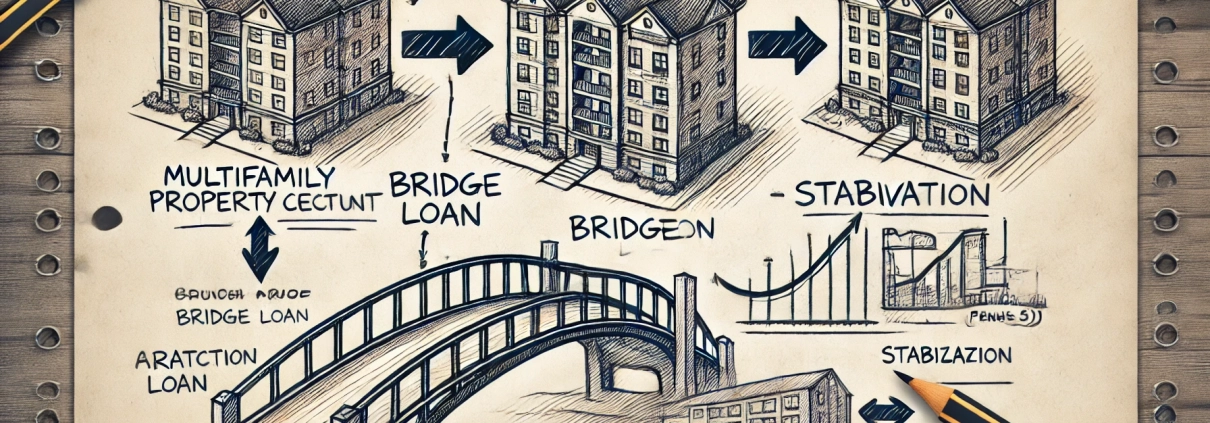Bridge Loan
Also referred to as a mini-perm, in real estate a bridge loan is a short-term loan typically provided to developers and value-add real estate investors and is used to “bridge” periods during which the property is not eligible for permanent financing. The term of a bridge loan can be anywhere from a few months to several years, and generally caries a higher interest rate commensurate with the higher risk to the lender.
Putting ‘Bridge Loan’ in Context
Scenario:
Big Sky Property Partners, a real estate investment firm based in Bozeman, Montana, specializes in value-add acquisition investments. The firm recently acquired a 150-unit market-rate multifamily property, The Lofts at Bridger Creek, located near downtown Bozeman. The property, built in the early 2000s, has strong potential but requires significant upgrades to the common areas, amenities, and interior units to meet current market demands and increase rents.
Use of a Bridge Loan:
Big Sky Property Partners identified The Lofts at Bridger Creek as an ideal value-add opportunity but faced a challenge. The property, in its current condition, did not qualify for long-term, permanent financing because of deferred maintenance and below-market rents. To bridge the gap between acquisition and stabilization, the firm secured a bridge loan for $12 million with a 3-year term at an interest rate of 7.5%.
The bridge loan was structured to cover the purchase price of $10 million and an additional $2 million for the planned renovations. The loan allowed Big Sky Property Partners to acquire the property and immediately begin renovations, which included upgrading the exterior, adding a modern fitness center, renovating the clubhouse, and updating unit interiors with new appliances, flooring, and fixtures.
The Role of the Bridge Loan:
The bridge loan was crucial in this scenario as it provided the necessary capital to acquire and reposition the property quickly. The higher interest rate of 7.5% reflected the higher risk associated with the property’s current condition and the uncertain timeline for achieving stabilization.
Big Sky Property Partners planned to complete the renovations within 18 months, after which they would lease-up the renovated units at higher rents. Once the property reached a stabilized occupancy of 95% with the desired rent growth, the firm intended to refinance the bridge loan into a permanent loan with a lower interest rate. This transition would allow them to lock in long-term financing at more favorable terms, thus improving cash flow and overall returns.
Outcome:
Assuming the renovations were successful and the lease-up met projections, The Lofts at Bridger Creek would appraise at a significantly higher value, enabling Big Sky Property Partners to refinance the bridge loan with a permanent loan at an interest rate of 5%. This refinancing would not only lower the firm’s debt service but also return some of the equity invested in the project, thereby increasing the overall return on investment.
In this case, the bridge loan played a vital role in enabling the acquisition and repositioning of the property, ultimately leading to a more stable and profitable asset.
Frequently Asked Questions about Bridge Loans in Real Estate
What is a bridge loan in real estate?
A bridge loan is a short-term loan used to “bridge” the period when a property does not yet qualify for permanent financing. It is commonly used by developers and value-add investors and generally carries a higher interest rate due to increased risk.
When is a bridge loan typically used?
Bridge loans are typically used when a property needs improvements or stabilization before it can qualify for permanent financing. In the example, Big Sky Property Partners used a bridge loan to acquire and renovate a multifamily property that had deferred maintenance and below-market rents.
What are typical terms of a bridge loan?
Bridge loans often have terms ranging from a few months to several years. In the case of The Lofts at Bridger Creek, the bridge loan was for $12 million with a 3-year term and a 7.5% interest rate.
How does a bridge loan benefit a value-add strategy?
Bridge loans provide immediate capital to acquire and reposition an asset. In the scenario, the loan funded both the acquisition and $2 million in renovations, enabling Big Sky Property Partners to increase rents and stabilize the property before refinancing into long-term debt.
What is the exit strategy for a bridge loan?
The typical exit strategy is to refinance into a permanent loan with a lower interest rate once the property is stabilized. Big Sky Property Partners planned to refinance at 5% interest after achieving 95% occupancy and increased valuation.
Why do bridge loans have higher interest rates?
Bridge loans carry higher risk because the property is not yet stabilized or producing its full potential income. As a result, lenders charge higher interest rates to compensate for the additional risk. In this case, the rate was 7.5%.
Click here to get this CRE Glossary in an eBook (PDF) format.

